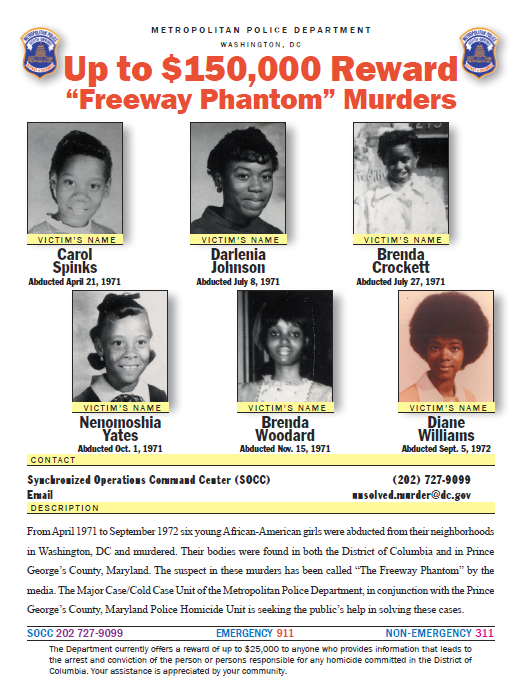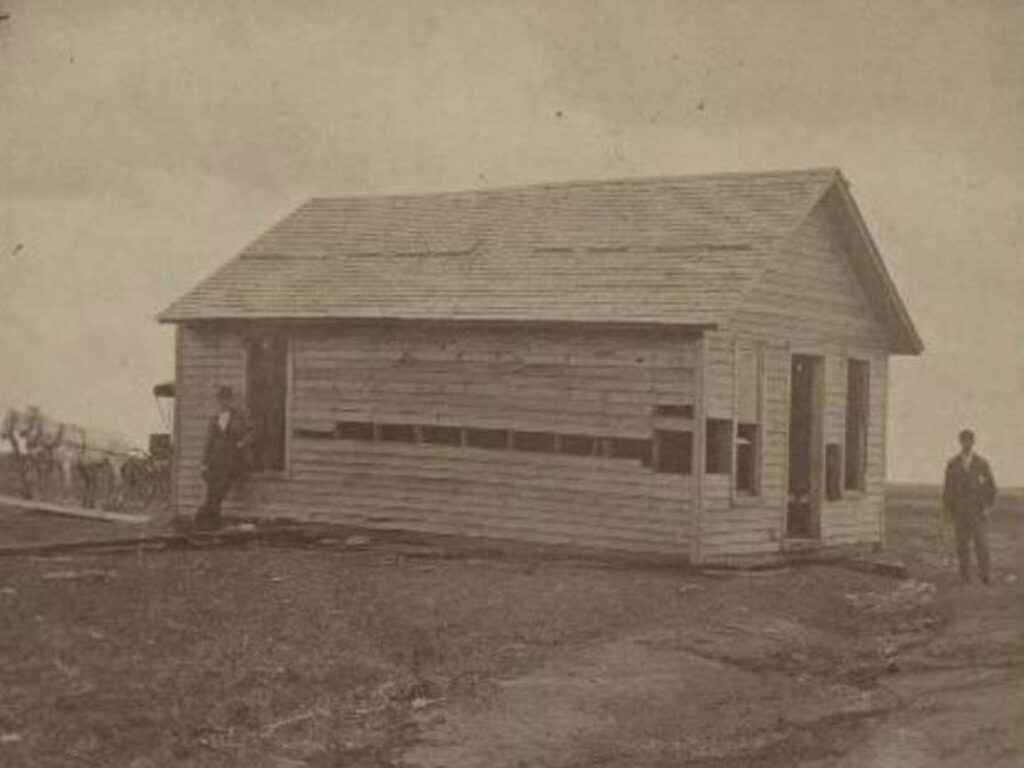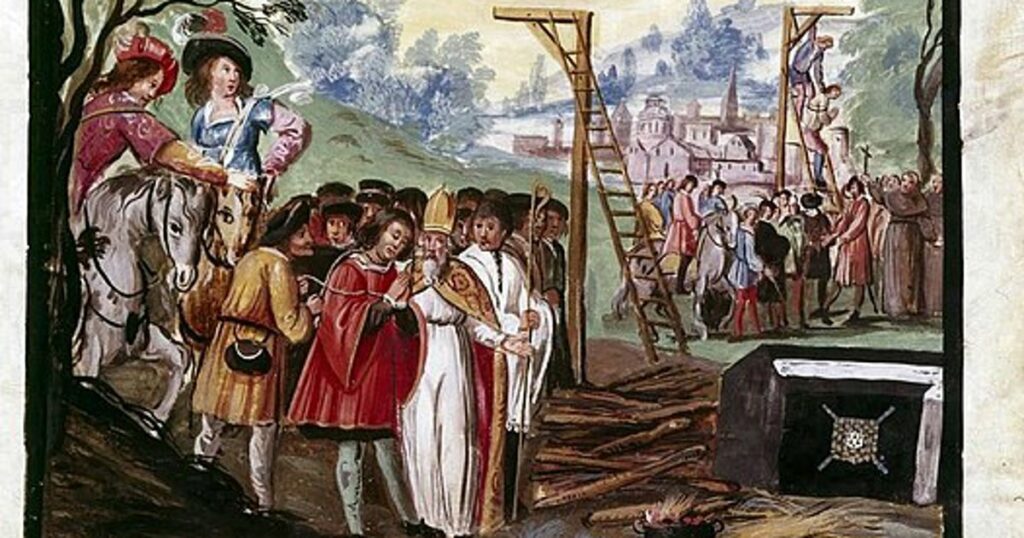Many mysteries are eventually solved and the truth is uncovered. But some mysteries linger like restless ghosts, haunting our collective consciousness and challenging our understanding.
Among these cases stands the haunting tale of the Freeway Phantom. This was a serial killer who struck fear into the heart of Washington, D.C. during the early 1970s.
Victim after victim was left dead near the sprawling freeways. But the Phantom’s identity remained elusive. They teased investigators and taunted the public with cryptic messages.
Delving into this dark history, which remains unsolved to this day, we confront a sinister puzzle that begs the question: What drives someone to such evil, and will they ever be found? Will the killer ever be brought to justice?
Or maybe, the chilling legend of the Freeway Phantom will forever remain a captivating, terrifying mystery to us all.

The Timeline
Between April 25, 1971, and September 5, 1972, a series of gruesome murders gripped Southeast Washington, D.C. These became known as the “Freeway Phantom” killings.
During this span of terror, six young Black girls, aged 10 to 18, fell victim to a sadistic predator who abducted, killed, and callously left their bodies near the I-295, the Anacostia Freeway. The heinous crimes shattered the lives of the victims’ families.
The first reported victim was 13-year-old Carol Denise Spinks. On April 25, 1971, she vanished while on her way home from a 7-Eleven store just across the Maryland border. Six days later, her lifeless body was discovered behind St. Elizabeths Hospital, near the northbound lanes of I-295.
The autopsy revealed signs of physical and sexual assault, alongside strangulation. This raised the chilling specter of a sadistic killer at large.
The gruesome spree continued, finally ending with the murder of 17-year-old Diane Denise Williams on September 5, 1972. Her strangled body was found dumped near I-295, just south of the District line.
The Victims
The Freeway Phantom’s reign of terror claimed the lives of six young girls. It began with thirteen-year-old Carol Denise Spinks.
Just months later, on July 8, 1971, 16-year-old Darlenia Denise Johnson disappeared on her way to work. She was found near the same location as Spinks. Her body was discovered by an anonymous caller.
Then on July 27, 1971, ten-year-old Brenda Faye Crockett vanished while running an errand. Her phone call to her family hinted at a stranger driving her away. She was never seen alive again.
Tragically, the spree continued. 12-year-old Nenomoshia Yates was kidnapped, raped, and strangled on October 1, 1971. Her body was found a few hours later in Prince George’s County, Maryland. Her shoes were missing.
On November 15, 1971, the life of 18-year-old Brenda Denise Woodard was brutally taken. She was stabbed and strangled near Prince George’s County Hospital.
The Phantom’s final victim, 17-year-old Diane Denise Williams, was discovered on September 5, 1972. She was also strangled. This brought a horrifying end to the chilling series of crimes.
At first, the murders could have seemed unrelated, but the connections and similarities were quickly noticed.
Modus Operandi
The same methods and tactics connected all six of the brutal killings. This led authorities to believe they were dealing with a serial killer.
The Freeway Phantom’s modus operandi was to abduct his victims while they were going to or returning from work or an errand. He would then rape and strangle them, usually manually, and dump their bodies in grassy areas near local freeways.
The Phantom was, however, savvy enough to wash his victims’ bodies to destroy evidence. His DNA was never recoverable. He also disposed of the bodies in different states. This was likely to keep different police departments from piecing the crimes together.
As is already clear, his victims were similarly chosen, too. The Freeway Phantom’s victims were all young African-American girls from neighborhoods in Washington, D.C.
A Taunting Note
And there was another hint that police were hunting for a serial killer – the note they left behind.
When authorities discovered the body of 18-year-old Brenda Denise Woodard, in one of her pockets was a note. It read:
this is tantamount to my
insensitivity to people
especially women.
I will admit the others
when you catch me if you can!
Free-way Phantom
Clearly, the killer had adopted the nickname the public had bestowed upon them.
After investigation, the note appeared to be written by Brenda herself. But more than likely, the killer had told her what to write.
The Investigation
The investigation into the Freeway Phantom involved a dedicated law enforcement task force. It was composed of detectives from various agencies, including the Metropolitan Police Department of the District of Columbia (MPDC), Maryland State Police, and even the Federal Bureau of Investigation (FBI).
In the following months and years, they followed up on numerous tips and leads from the public and other law enforcement. However, despite their best efforts and the interest of the public, no lead provided sufficient evidence to identify the killer.
The strain on relations between police and the community added to the difficulties. Over time, many of the case files were lost. As a result, reopening the case today would be nearly impossible.
To this day, the Freeway Phantom case remains an open and unsolved cold case. This leaves the families of the victims and the community forever wondering if the killer is still out there.
Theories & Continued Interest
During the investigation, several different suspects and theories emerged. Some pointed to members of a gang known as the Green Vega Rapists, who were connected to multiple crimes in the Washington, D.C. area.
Interviews with imprisoned members yielded intriguing information. One inmate provided details about a beltway homicide that matched Freeway Phantom details known only to detectives.
However, the informant withdrew cooperation and the investigation sputtered.
Another set of suspects, two ex-cops, were initially arrested for a murder mistakenly thought to be a Freeway Phantom victim, but this was a false lead.
Finally, Robert Elwood Askins, a 58-year-old computer technician, was also considered a suspect due to his criminal history, including charges of abduction, rape, and past murder cases.
He had been an informant assisting law enforcement in the arrests of prostitutes. He had connections to words found in the killer’s notes. But no concrete evidence tied him to the Freeway Phantom killings.
Despite continued interest, the true identity of the Freeway Phantom remains elusive, and the case continues to haunt the public’s imagination to this very day.
References
Ferguson, Malcolm. “The Story behind DC’s ‘Freeway Phantom’ Serial Killer.” Washingtonian, May 22, 2023. https://www.washingtonian.com/2023/05/22/the-story-behind-dcs-freeway-phantom-serial-killer/.
Wilber, Del Quentin. “‘freeway Phantom’ Slayings Haunt Police, Families Six Young D.C. Females Vanished in the ’70s.” The Washington Post, June 26, 2006. https://www.washingtonpost.com/archive/politics/2006/06/26/freeway-phantom-slayings-haunt-police-families-span-classbankheadsix-young-dc-females-vanished-in-the-70sspan/08789f47-3d0e-4a88-ad24-cdbcc493698f/.

